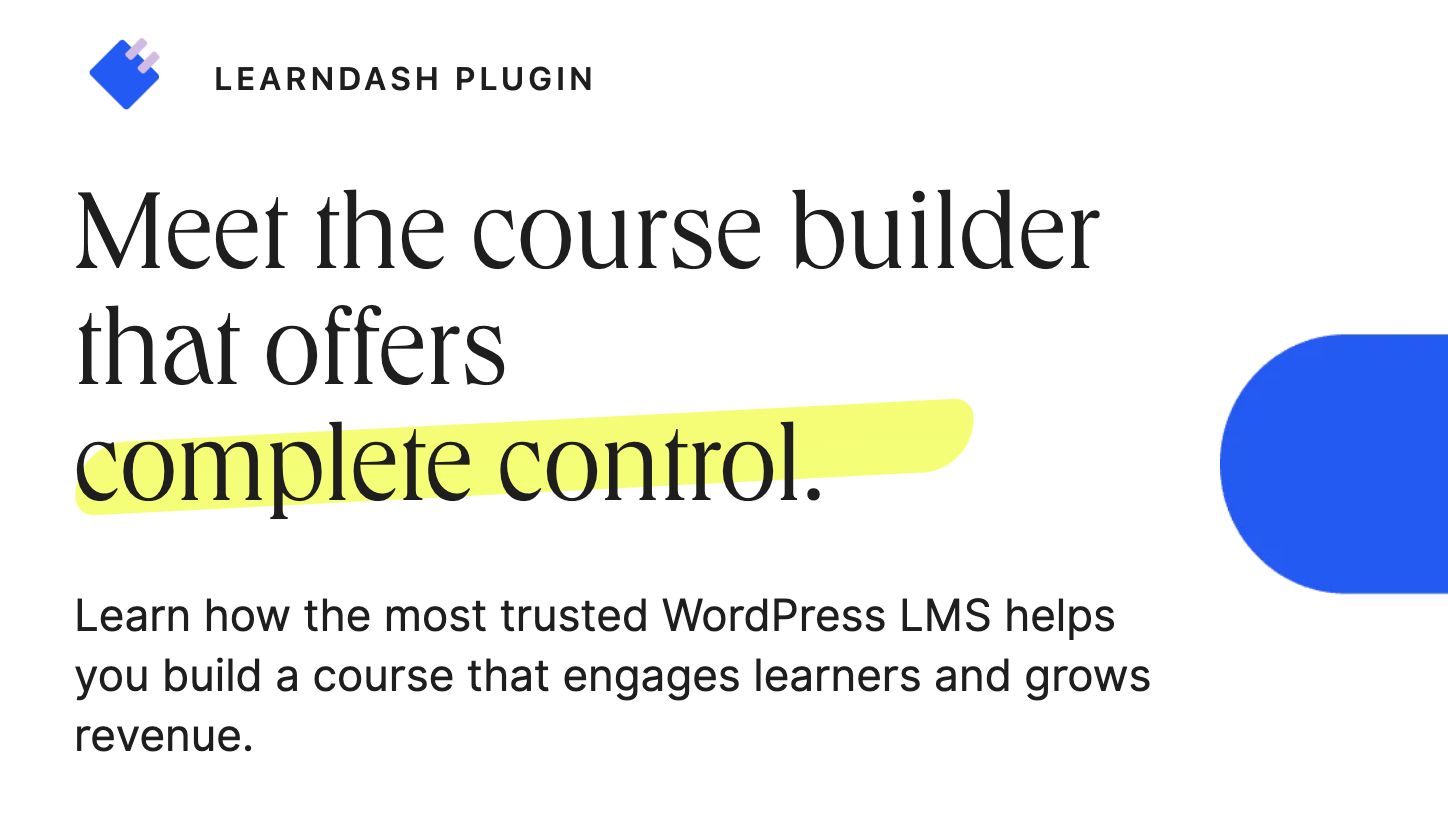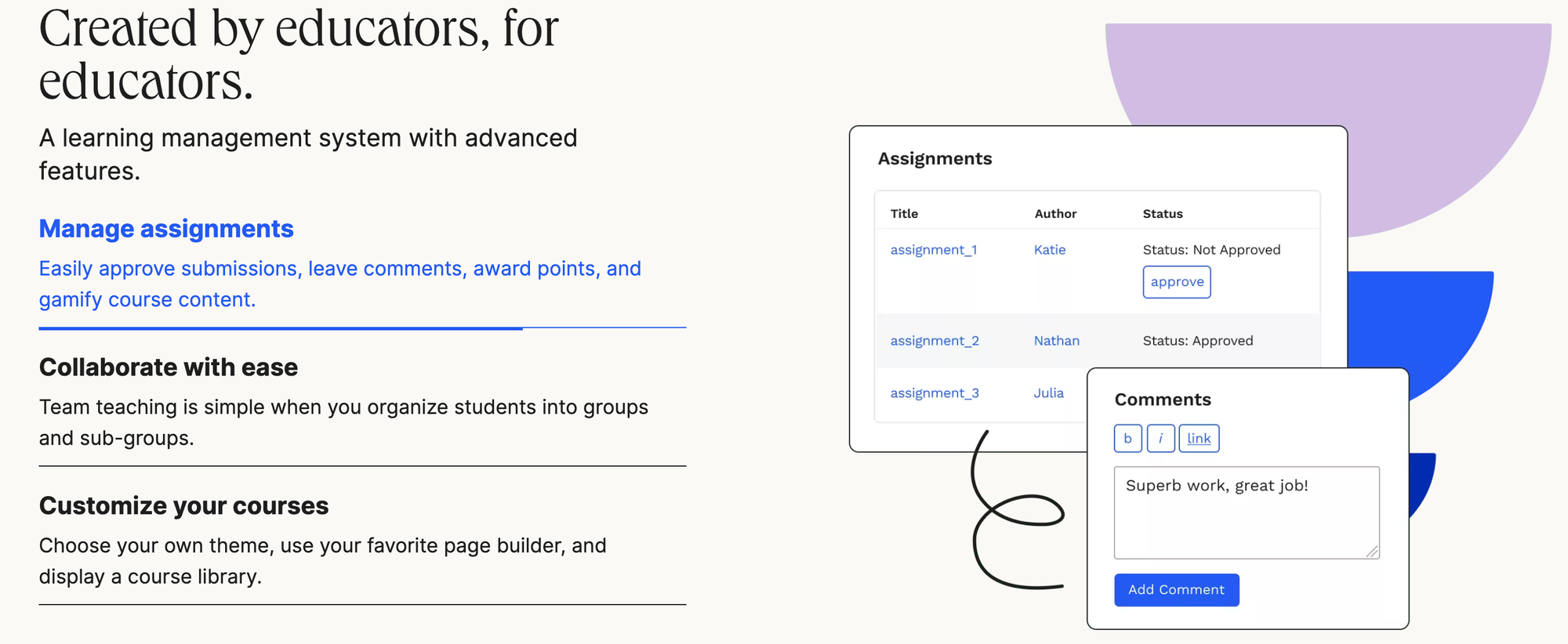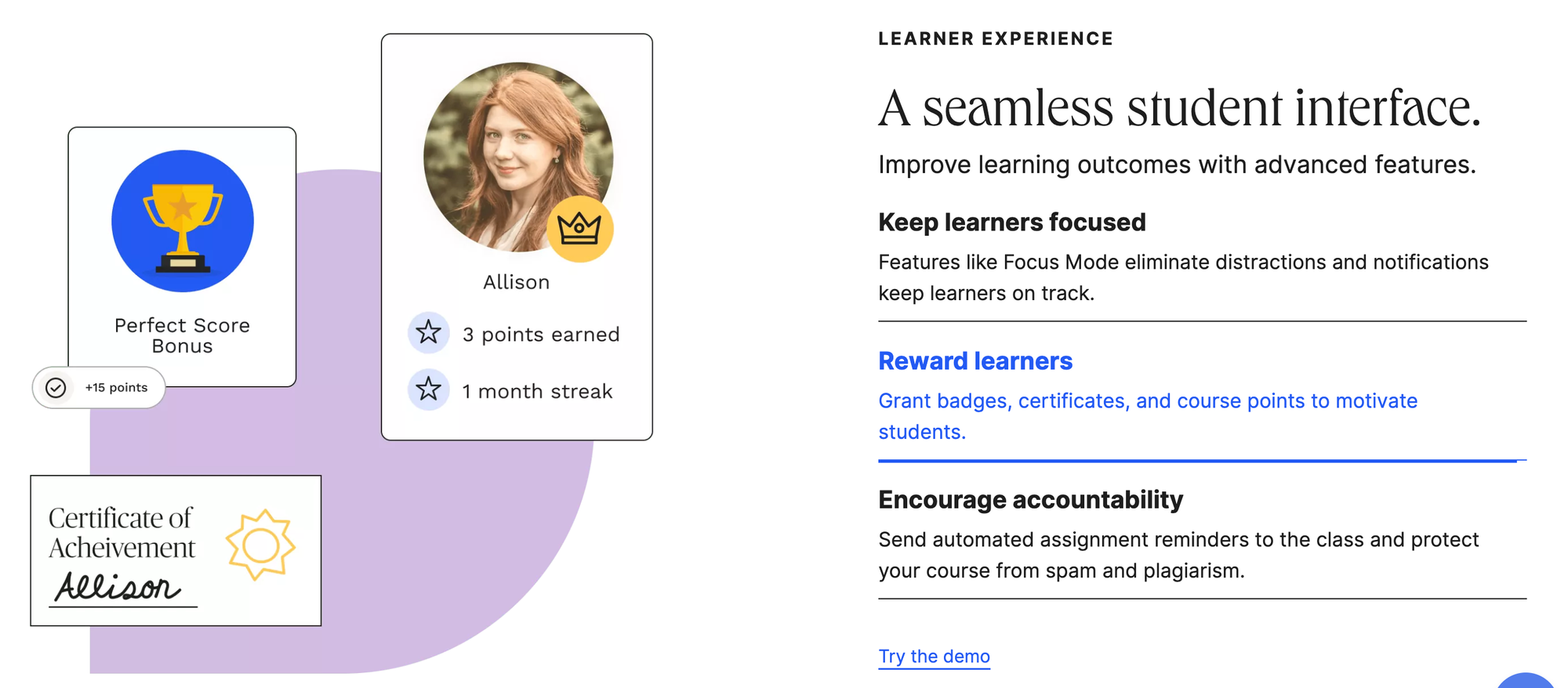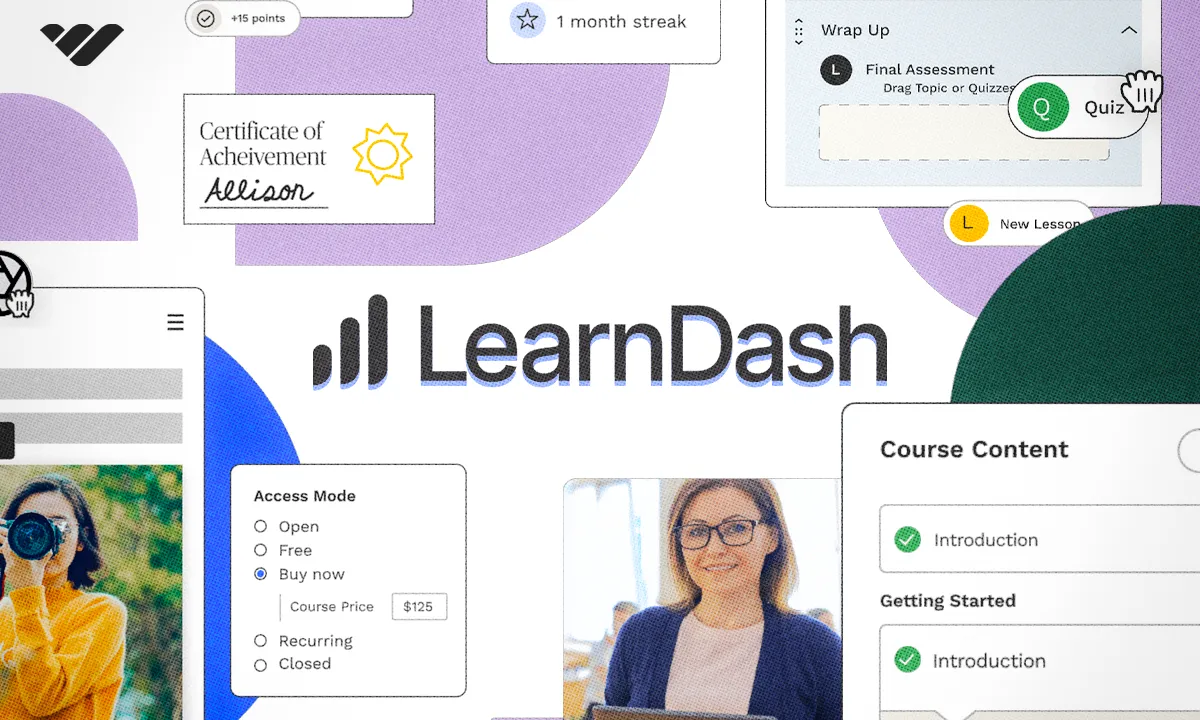LearnDash is a Wordpress LMS plugin for course creators - but how does it work? Read this review to find out all you need to know.
Key takeaways
- LearnDash is a WordPress LMS plugin ideal for users comfortable with WordPress who want full control over course design and branding.
- Monetizing courses requires third-party payment plugins since LearnDash lacks built-in payment processing.
- The plugin costs $199/year plus hosting fees, making it a significant upfront investment before earning revenue.
More and more students, of all ages, are studying online, so much so that the online learning industry has grown by 900% since 2020.
Remote learning makes courses accessible to people who might otherwise be unable to study. For example, time-strapped individuals can learn at their own pace, on their phones, and people who live in remote areas can study from the comfort of their homes, without having to make a long journey to the nearest city.
As a result, there are many businesses who cater to the online learning industry, creating software and products to facilitate online education. LearnDash is one such business, as a course management and online learning plugin for WordPress. LearnDash helps teachers and subject matter experts create online courses.
Here, we'll look at the features and benefits of LearnDash, how much it costs, and how it compares to other course platforms.
What is LearnDash?

LearnDash is a Learning Management System (LMS) plugin for WordPress. It enables anyone to create structured lessons and courses. The plugin also helps course leaders keep track of their students and monitor their progress. LearnDash is easy to set up and requires no technical expertise beyond being able to install and manage WordPress plugins.
Who can use LearnDash?
LearnDash is aimed at tutors, teachers and niche experts who'd like to create and publish their own online courses. To use LearnDash, you'll need to have a WordPress website, or some web hosting capable of running WordPress. The server requirements aren't high, but it's worth double-checking before trying to set up the plugin:
- PHP 7.4 or newer
- MySQL v5.6 or higher (alternatively MariaDB v10.1 or newer is also supported)
- HTTPS support
- A PHP memory limit of 128MB or higher
If you're already running WordPress, your hosting probably meets the above requirements. Contact your web developer or hosting company to check any details you're unsure about.
If you can't or don't wish to run a WordPress site, you can still use LearnDash because the company offers a hosted option called LearnDash Cloud. This subscription-based offering provides most of the features of the WordPress platform, but the developers manage your site for you, freeing you to focus on creating great courses for your students.
The key features of LearnDash

LearnDash is a powerful and flexible LMS that integrates with various popular WordPress plugins and third-party services, including WooCommerce, BuddyPress, PayPal, GravityForms, and more. It supports Zapier integration, so it has the potential to connect to hundreds of third-party services.
The primary purpose of the plugin is course management, and it does a good job of delivering that, offering:
- Your branding on your content
- Multi-tier courses
- Lesson timers
- Drip-feed content for aced learning
- Gamification features such as points, certificates, and badges
- Focus Mode for learners
- Discussion forums
- Assignments
- Detailed analytics and reporting
- Expire learner access
- Numerous plugins for groups, grades, notes, and more
- E-commerce features
Because LearnDash is a plugin that runs on top of a WordPress site, it offers far more flexibility than a traditional course management platform. You can add extra features to the site, customize the theme, choose your own domains and subdomains, and generally extend or tweak your site (and your courses) in ways you wouldn't be able to if you were hosting on Udemy or other similar platforms.
How easy is it to create an eLearning site with LearnDash?

If you're already familiar with WordPress, you'll find LearnDash incredibly easy to use, because it's all located in the WordPress admin panel, and us0es the same kind of interface you'd be used to from adding posts and pages.
Creating courses
Creating a course is simple. When you're logged in to your WordPress site as an admin, select New > Course from the admin bar at the top of the screen, or open LearnDash LMS in the admin panel itself, choose Courses and click Add New.
Alternatively, if you want a bit of a headstart with creating your course, choose Create Course Outline from AI to have LearnDash automatically populate some of the fields based on prompts. It won't write an entire course for you, but it's a great way to get some inspiration if you struggle to think of titles and categories.
The course editor is divided into five sections:
- Dashboard: This shows information about the course, such as the number of lessons, topics, and quizzes in it, how many students you have, and recent enrollment statistics.
- Course page: Here you can edit the page prospective students will see when they look up information about the course. This editor is very similar to the one you'd use when creating posts or pages for your website.
- Builder: You'll do the bulk of your work here, creating sections, lessons, and quizzes. This drag-and-drop editor lets you move lessons around, and map out how the course will progress. Once you've decided on your lesson plan, you can select a lesson and click Edit to open the WYSIWYG editor and add content to that lesson.
- Extend Access: If you want your course to expire (for example at the end of an academic year), you can configure expiration dates here, or extend course access for certain enrolled users.
- Settings: This section offers options for restricting access to the course, setting pre-requisites, limiting the number of enrollees, and determining whether learners can jump around the course content, or whether they must complete the modules in order.
Managing multimedia content

The editor allows you two images, and you can also share video content via Vimeo. As a result, you have to rely on third-party hosting for your videos.
If you're worried that users will skip or ignore videos, you can go to the Settings tab of the Lesson page and turn on Video progression which will prevent your users from skipping to the next lesson if they haven't watched the video first.
LearnDash also offers other options for pacing learner progress, including lesson timers and graded assignments. Unfortunately, you can't use timers and video progression at the same time, but you can use either of those features alongside quizzes/assignments.
Adding quizzes
Adding a quiz is just a matter of clicking New Quiz when you're on the Builder tab. After providing a name for the quiz, click Add Quiz, then click Edit to open the Quiz page. This will take you to the editor. The screen you land on is the one where you provide an intro to the quiz. At first this can be confusing – how do you add questions and answers, for example?
To add questions, you must navigate to the Builder tab. You can create new questions, or add ones you've already defined. There are several question types, including:
- Multiple choice
- Single choice
- Free choice
- Sorting or Matrix sorting
- Fill in the blank
- Assessment
- Open answer/essay
You can set the number of points each question is worth, and even configure a different worth for each answer, for example, if there's more than one correct answer, or you want to give partial credit for certain answers on a multiple-choice quiz.
As you add questions to the quiz, you'll see the number of points the quiz is worth in total. Once you've finished creating the quiz, you can assign it to a lesson, and edit that lesson to set whether users have to pass the quiz before they can move on to the next module.
Issuing certificates

Students expect to receive something to commemorate that they've completed a course. LearnDash makes it easy to award learners with a downloadable certificate, customized with their name and the date they completed the course.
To set up certificates, all you have to do is provide an image that you'd like to use for the certificate, and then specify where you'd like details such as the learner's name, course name, date, and issuer's signature to go. All of this is managed via a simple drag-and-drop interface. Set it up once, set the issuing criteria for the certificate, and you're good to go. LearnDash will auto-generate certificates for students when they pass the required quizzes or complete the course.
Extending LearnDash with add-ons
Out-of-the-box, LearnDash has everything you need for making courses, and some decent tools for tracking your learners too. If you tend to work with small cohorts or you're offering your content to a relatively niche audience, you may be completely happy with the stock plugin.

For those who need to manage a larger group of students or who wish to monetize their courses, LearnDash offers a variety of plugins that make the job easier, including:
- Instructor roles
- Gradebooks
- Achievements
- Zapier Integrations
- Restrict Content for LearnDash
- Gravity Forms for LearnDash
- Easy Digital Downloads for LearnDash
- bbPress for LEarnDash
- Migration tools (Migrate from LearnPress, Tutor LMS or Sensei LMS)
- Stripe for LearnDash
- 2Checkout for LearnDash
The above are just a few of the add-ons available. There are many others. If you want to monetize your courses, you'll need to install one of the member site or payment processing add-ons, as you cannot do this in LearnDash itself.
Most of the add-ons are free, but there are a couple of premium ones. Fortunately, these are clearly marked so you can tell at a glance whether there'd be an extra cost to use them.
LearnDash pricing
LearnDash is sold in two forms. There's the LearnDash LMS WordPress plugin, and the hosted LearnDash Cloud solution.
LearnDash LMS costs $199/year for a single site license. You can purchase a ten-site license for $399/year, or an unlimited license for $799/year. If you go this route, keep in mind you'll also need to pay for web hosting, and take care of any of the technical aspects of managing your WordPress site yourself. All of these costs can quickly add up.
LearnDash Cloud costs $29/month for the starter license if you pay monthly, or $25/month if paid annually. The developers also have Growth and Pro plans offering increased multimedia storage space and bandwidth, for an extra fee.
Is LearnDash worth it?
LearnDash is flexible, extensible, and powerful, giving course creators an incredible amount of control over the look and feel of their courses. However, this comes with a price.
To really have success with LearnDash, you need to be comfortable with WordPress to be able to make the most of the site's features. You also need to integrate third-party plugins if you want to make money with your courses. Plus, with LearnDash LMS costing $199 per year plus your web-hosting cost and associated fees, you're out of pocket before you've made your first sale.
If you're not interested in tinkering with the backend of a WordPress site, or want a lower-cost option with less financial risk, you might prefer to share your content on an alternative platform.
Read this guide to find the best LMS platforms for selling courses online.
Sell courses, subscriptions, and more with Whop

For those who want to focus on making and marketing great courses, without any technical overhead, there's a great alternative to LearnDash - Whop.com.
Whop is a social commerce platform that's free to join and offers a huge variety of features, including private communities, ebooks, and an intuitive, powerful course creator.
With Whop, you can provide text, audio, and video content for your students, create quizzes and assignments, and keep track of learner progress all in one easy-to-use dashboard. All of these features are native to Whop, meaning that you do not have to use third-party integrations. Whop is a true all-in-one platform - you can create your course, build a community around it, upload ebooks, host video calls, offer downloadable files and more, all from within your very own whop. Plus, you can sell access to one of all of these features using Whop as your payment processor.
There are no up-front fees to join the platform. All you pay is a 2.7% + $0.30 commission on any sales you make, meaning that you can launch your business risk-free.
Join Whop for free today and build your online course empire.
Frequently asked questions
Can you make a member site with LearnDash?
The LearnDash developers offer a plugin called MemberDash which can be used for membership sites. You can also use other third-party plugins alongside LearnDash to manage your site's memberships.
Can you issue course completion certificates with LearnDash?
There is a certificate creation feature built-in to LearnDash. You can use this to send a personalized certificate to learners when they achieve the course completion criteria.
Can you run a student forum with LearnDash?
LearnDash offers integration with BuddyPress, bbPress, and other WordPress community plugins via add-ons. This means you have several options when it comes to offering a student forum.



